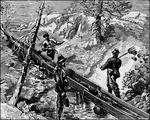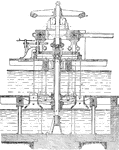Clipart tagged: ‘Sluice’

Centrifugal Pump
"A centrifugal pump differing from an ordinary centrifugal pumps in one feature only. The water rises…

Irrigating with Furrows
"Irrigating young orchard with furrows. a, sluice; b, head ditch; c, furrow." -Department of Agriculture

Guideblade Chamber
"The sectional form of the guideblade chamber and the wheel and the curves of the wheel vanes and guideblades,…

Guideblade Chamber
"The sectional form of the guideblade chamber and the wheel and the curves of the wheel vanes and guideblades,…
Sluice
"One of the simplest forms of sluice as used in river diggings in the north-west of America. A rectangular…

A Sluice Box - Miners Work in the Forest
"In mining, a trough made of boards, used for separating gold from the gravel and sand in which it occurs.…

Girard Turbine
"The general sectionl elevation of a Girard turbine, in which the flow is axial. The water, admitted…

Water Wheel
"When a water fall ranges between 10 and 70 feet, and the water supply is from 3 to 25 cubic feet per…